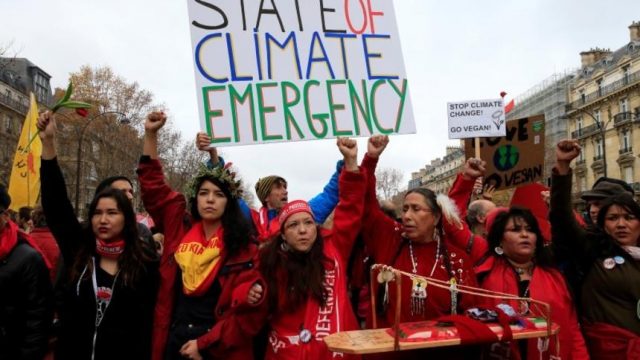John Andrist: Intellect Applied . . . or Just to Argue?

Representatives of indigenous peoples demonstrate in Paris, France, as the World Climate Change Conference 2015 (COP21) continues at Le Bourget, December 12, 2015. REUTERS/Pascal Rossignol
It’s almost 70 years since I was a high school student, but I still remember a discussion from our Present Day Problems class when we were seniors.
The earth’s population was about 2 billion people, and the scientific community was debating at what point population growth would create mass starvation.
They could not have conceived that today there would be 8 billion of us driving more than a billion cars, consuming food and water, heating and cooling our homes, producing four times as much waste, and filling our air with polluting gases — like methane — and still be dealing with surplus food production.
Why do we have so much food on this planet? We keep losing thousands of acres of food production to make room for our growth in numbers — housing, wider roads, airport runways and other urban sprawl. So, why? Applied science is the easy answer.
It’s always clear to see what has happened. It’s more difficult to know what will happen.
Science today is stuck on the hypotheses of CO2 and global warming. We know there has been a growing concentration of CO2 in our atmosphere, and that CO2 contributes to global warming. It’s silly to suggest otherwise.
Yet we conveniently dismiss the possibility that CO2, which is the fuel of all growing food, likely plays some part in food production.
[mks_pullquote align=”right” width=”300″ size=”24″ bg_color=”#ffffff” txt_color=”#000000″]Government is rarely smart.[/mks_pullquote]
What we can’t know, but tend to accept as if we did, is whether that change can or will be reversed. Warming alarmists have no more to back them up on what will happen than do warming deniers.
There is a logical supposition of human activity contributing to shrinking ice caps, just as the benefits of warmer weather include the supposition of enhanced growth of food and fauna.
So the whole discussion changes little, other than to become one more thing that divides us.
Is anybody studying the possibility that nothing we can do will reduce our carbon footprint? What if the sea level rises even more than predicted?
Is anybody discussing the things we might do to protect our coast lines if the sea level does rise to problematic proportions?
The Fargo region is spending huge sums of money for the hope of Red River diversion to prevent future floods. They may never get it.
But at the same time, somewhat more quietly, they have been building protections for future flood possibilities.
That’s smart. Call it hedging the bets. We need that same kind of voice in the science of climate change.
So far that voice seems to be limited to noise and conflict.
It is not a denial of global warming to believe we would be smarter to be spending our money — at least for the next couple of decades — to figure out better ways of dealing with those problems we fear we are creating.
One thing we must certainly know is that short of a nuclear showdown, we are going to continue our growth in body creation.
Ten billion? Twelve billion? Twenty billion?
Even the great plagues and the great wars have never been able to reverse that trend. Nor has birth control, abortion, family planning, or euthanasia.
Meanwhile, forgive me for hoping we have another warmer than “normal” winter, whatever normal is.
One more thing
The government, which took over flood insurance, is extremely upside down, deeply in debt.
The simple explanation for that is they didn’t have actuaries, or the ones they used aren’t very smart.
Government is rarely smart.
For some reason most of us love to live near the water or in flood prone valleys.
To some degree that’s like hitting our heads with a hammer, because it feels so good when we quit. As a simple matter of self-preservation we would be smart to do more of our building on higher ground.




